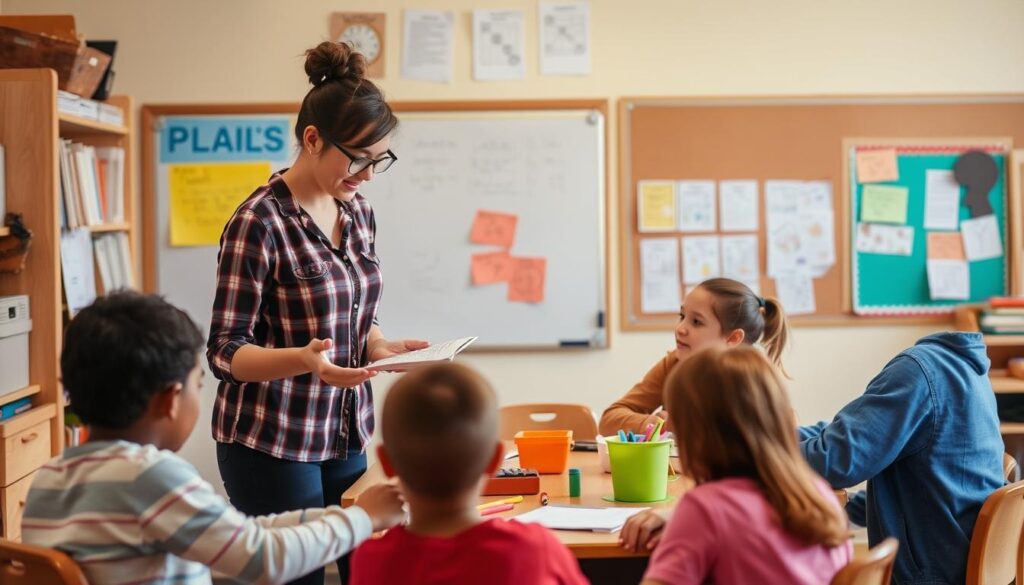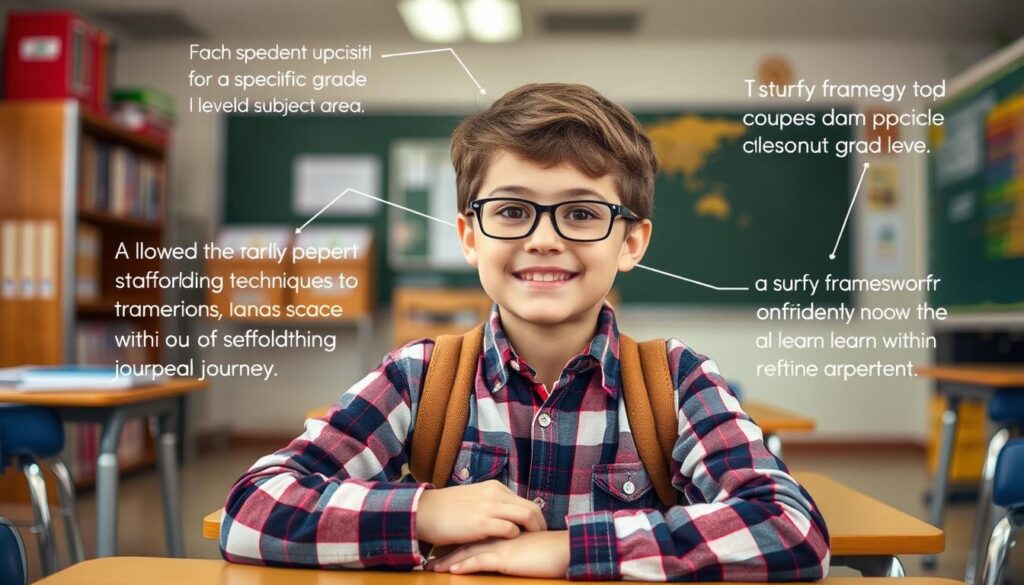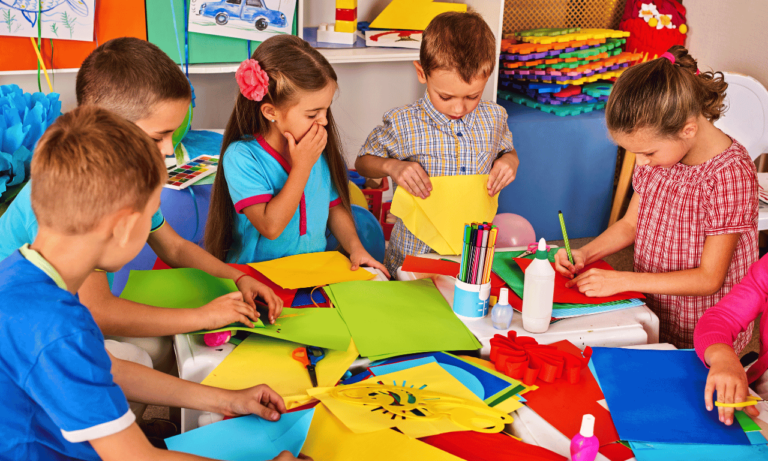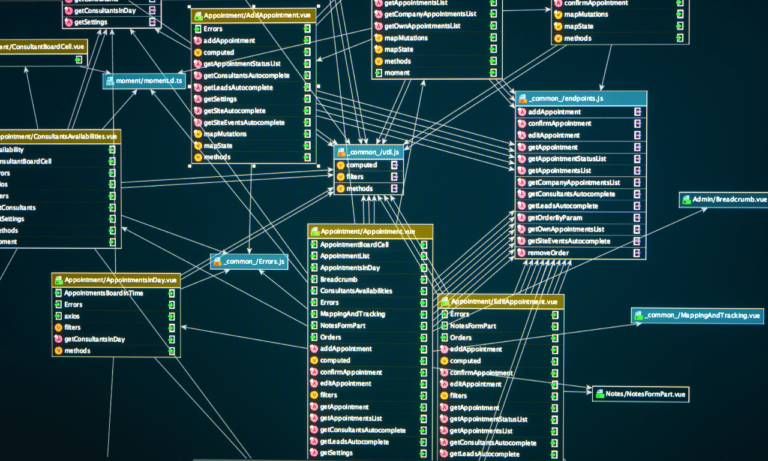Phone:
(+65)8319-0742
Scaffolding in education is a key way to help all students learn and grow. It gives them support that they can use and then let go of as they get better. This student-centered learning method helps students learn by themselves and use what they already know.
Teaching with scaffolding means giving the same lessons to all students but helping each one in their own way. It’s about guiding them to learn more by working in their own special zone. This zone is where they can do things on their own but need a little help to go further.
Teachers break hard tasks into smaller steps and give specific help. This way, students can move from where they are now to where they could be. It helps them grow in school and feel more confident and independent. They start to own their learning.
Key Takeaways:
- Scaffolding is a student-centered learning approach that provides temporary support to help students reach their full potential
- Educators use scaffolding teaching techniques to create a constructivist learning environment that builds upon students’ prior knowledge
- Scaffolding enables students to work within their Zone of Proximal Development, fostering growth and independence
- By breaking down complex tasks and providing tailored support, scaffolding empowers students to take ownership of their learning
- Scaffolding builds confidence and independence, preparing students for future academic challenges
Understanding the Concept of Scaffolding in Education
Scaffolding is a key method in education that helps students learn and grow. It comes from the work of psychologist Lev Vygotsky. This approach has changed how teachers help students learn.
Defining Scaffolding and Its Origins
The term “scaffolding” started in the 1970s. It compares to the temporary structures in building projects and the help teachers give students. Just as scaffolds help workers reach high places, educational scaffolding helps students learn hard topics with teacher support.
Scaffolding breaks down hard topics into smaller parts. Teachers use scaffolding strategies to help students. This creates a supportive place that makes students more engaged, confident, and grows their knowledge.
The Zone of Proximal Development and Its Role in Scaffolding
Vygotsky’s Zone of Proximal Development (ZPD) is key to scaffolding. It shows the gap between what students can do alone and with help. This idea is about learning with the support of someone more knowledgeable.
According to Vygotsky, children learn best when they interact with those who provide guidance and encouragement to master new skills.
Scaffolding helps students move from where they are to where they could be. Teachers give specific help and slowly let students do more as they get better. This helps students go through the ZPD and learn more.
| Scaffolding Benefits | Impact on Student Learning |
|---|---|
| Enhances information retention | Facilitates long-term memory and recall |
| Bridges foundational knowledge with new concepts | Promotes meaningful connections and deeper understanding |
| Boosts student engagement | Encourages active participation and motivation |
| Minimizes frustration and negative effects on confidence | Fosters a positive learning environment and growth mindset |
| Encourages communication | Facilitates collaborative learning and peer support |
Using the ZPD and scaffolding, teachers can help students reach their full potential. This leads to success in school and a love for learning.
Key Strategies for Effective Scaffolding in the Classroom
To help students grow and succeed, teachers must use scaffolding in smart ways. They should adjust teaching to fit each student’s learning needs. This approach creates a supportive classroom where students can think for themselves and actively participate. Using visual aids, hands-on activities, and technology can make learning better for all students.
Adjusting to the Zone of Proximal Development
Understanding and adapting to each student’s Zone of Proximal Development (ZPD) is key to scaffolding. Teachers find the gap between what students can do alone and with help. This targeted support boosts inquiry and performance in students.
Encouraging Active Participation
Getting students involved in learning is vital for scaffolding. Interactive elements like group talks, working with peers, and hands-on tasks make learning exciting. “Think, Pair, Share” helps everyone join in and improve their speaking skills. This builds confidence and deepens understanding.
Harnessing Visual Aids
Visual aids are crucial for scaffolding. They help students understand complex ideas better and remember them. Tools like graphic organizers and real-life examples make hard concepts easier to grasp. Examples show how visual aids support learning at all levels.
Personalized Learning Paths
Customized instruction is a big part of scaffolding. It recognizes that students learn in different ways and at different levels. Teachers create paths that meet each student’s needs. This might mean different assignments or using technology to adjust content. Tailoring instruction helps create a supportive classroom for all students.
Scaffolding is not a one-size-fits-all approach; it requires ongoing assessment, adaptation, and refinement to ensure that each student receives the appropriate level of support and challenge.
Using these strategies can change the classroom into a place where students feel empowered. By adapting to each student’s abilities, encouraging them to participate, using visual aids, and personalizing learning, teachers help students bridge the gap between what they know and what they can do. As students grow, they gain confidence and independence to handle harder tasks and achieve more in their studies.
Scaffold in Education Meaning: Bridging the Learning Gap
Scaffolding in education means giving students the support they need to learn new things. It’s especially helpful for English Language Learners (ELLs) who need extra help. A third-grade teacher showed how scaffolding can really help ELLs grow and improve their language skills.
Scaffolding uses two main ideas: clear instructions and slowly giving less help. Clear instructions help students learn new stuff. Slowly giving less help means students start to do things on their own.
This way of teaching is based on psychologist Lev Vygotsky’s idea of the Zone of Proximal Development. It means giving students just the right amount of support when they need it.
For ELLs, good scaffolding includes teaching new words before class, using what they already know, and showing how to speak in an academic way. It also means using pictures, breaking learning into smaller parts, and working together. These methods help students learn new languages and do better in school.
Scaffolding is meant to be temporary, helping students until they can do things on their own. But, if teachers keep using scaffolds too long, students might not learn to be independent. Teachers should give students grade-level content and use scaffolds to help them meet their goals.
“Scaffolding is not about making things easier, but about making things possible.” – Dr. Carol Ann Tomlinson, University of Virginia
Here are seven ways to scaffold instruction:
- Activating prior knowledge
- Building prerequisite knowledge
- Using mini lessons
- Incorporating visual aids
- Providing Think-Write-Talk time
- Encouraging intentional practice
- Introducing increasingly complex questions or tasks
Scaffolding works differently in various subjects. In reading and ELA, it might mean teaching new words or using graphic organizers. In math, it could be about building on previous concepts. If tasks are too hard or not supported enough, students might get frustrated or feel like they can’t do it.
The true power of scaffolding is in helping students overcome learning gaps and take charge of their education. By giving clear instructions and slowly reducing support, teachers help students master tough subjects. As students get better and more confident, they can handle harder tasks, leading to ongoing growth and success. For more information on scaffolding in construction, visit https://scaffoldtype.com/single-scaffolding/.
Scaffolding Techniques for Different Subjects and Grade Levels
Scaffolding techniques are very flexible, fitting into many subjects and grade levels. They help students learn and grow. By adjusting scaffolding to fit the content and age, teachers make learning fun and effective. Studies show that scaffolding helps students do better in their studies.
Scaffolding in Reading and Writing
In reading and writing, scaffolding is key for improving comprehension and language skills. Guided reading is very helpful, where teachers work with students to support them. They pick texts that match the students’ reading level and use prompts and questions to help them.
Graphic organizers and sentence frames also help students. They make writing easier by organizing thoughts and structuring writing.
Scaffolding provides students with the necessary support to overcome challenges and build their confidence, as well as helping them see connections between new information and what they already know.
Supporting Math Problem-Solving
Math can be tough for many students, but scaffolding can make it easier. Using math manipulatives like counters and blocks helps students understand math better. Teachers break down hard problems and use visuals to guide students through solving them.
This approach helps students understand math concepts better. Scaffolding in education helps students learn and do things on their own over time.
Tailoring Scaffolding to High School Students
As students get older, scaffolding needs to change to meet their new abilities. High school students need scaffolding that challenges them to think deeply and solve problems on their own. Project-based learning is great for this.
It lets students use what they know to solve real problems. Teachers guide them but let them take charge of their learning. This helps students learn to learn by themselves and prepares them for college and beyond.
| Scaffolding Technique | Benefit |
|---|---|
| Guided Reading | Improves comprehension and literacy skills |
| Graphic Organizers | Enhances organization and higher-order thinking skills |
| Math Manipulatives | Supports understanding of abstract mathematical concepts |
| Project-Based Learning | Fosters critical thinking and self-directed learning in high school students |
Using scaffolding in different subjects and at various grade levels helps create a supportive learning environment. As students get more confident and skilled, they start to take charge of their learning. They become ready to face any challenge that comes their way.
Applying Scaffolding in Practice: Real-World Examples
Scaffolding is a key tool in education that helps students learn and grow. It gives students the support they need to understand and develop new skills. This approach makes learning more engaging and effective.
Whole-Class Integration
Using scaffolding in whole-class teaching helps all students learn better. Teachers can use tools like graphic organizers to make complex ideas clearer. These tools are great for students reading tough texts or learning new things.
To make learning together work well, teachers plan thought-provoking questions. These questions should be specific, guiding, and open-ended. They help students think deeply and actively participate in class. Teachers can use different scaffolding methods, like group discussions or think-pair-share, to meet students’ needs and build a supportive classroom.
Formative Assessments and Adjusting Scaffolding Strategies
Formative assessments are key to checking if scaffolding works and making changes as needed. They can be quizzes, homework, or peer reviews. These assessments show how students are doing and what they need more help with.
Diagnostic assessments are also important at the start of a lesson or unit. They check what students know and can do. This helps teachers give the right support and challenge to each student, helping them grow.
By watching how students do and changing scaffolding as needed, teachers can make learning dynamic and responsive. This way, they meet the changing needs of their students. It’s based on the idea of the zone of proximal development by Lev Vygotsky. This concept talks about giving support to help students bridge the gap between what they can do alone and where they need help. For more on effective scaffolding, check out scaffoldtype.com.
| Scaffolding Strategy | Benefits |
|---|---|
| Graphic Organizers | Help students visually represent ideas, organize information, and understand complex concepts |
| Thought-Provoking Questions | Encourage active participation, check understanding, and promote critical thinking |
| Formative Assessments | Provide feedback on student progress and inform necessary adjustments to scaffolding strategies |
| Diagnostic Assessments | Gauge prior knowledge and current skill level, allowing for personalized support and targeted instruction |
The Benefits of Scaffolding for Student Growth and Success
Scaffolding in education changes the game for student success. It helps learners tackle tough content with ease and understand complex ideas better. Teachers give focused support, letting students lead their learning. This builds a strong sense of ownership and motivation that lasts.
Scaffolding is key for mastering hard content. It breaks down tough tasks into smaller steps and offers support at each step. This helps students build confidence and resilience. It also prepares them to handle future challenges on their own.
Scaffolding boosts lifelong learning skills too. It encourages students to be active in their learning and gradually takes away support as they get better. This helps them develop skills like critical thinking and problem-solving needed for the 21st century.
It also makes learning a positive experience. Teachers give specific help and feedback, making students feel confident and ready to learn more. This creates a supportive classroom where students work together, share ideas, and celebrate each other’s wins.
“Scaffolding is not simply a matter of providing help to students; it is a matter of providing just the right amount and kind of help at just the right time.” – J. P. Gee
Scaffolding’s impact goes beyond school. It gives students the skills they need for life and work. It builds a strong base of knowledge and strategies for tackling life’s challenges. Students ready for lifelong learning or entering the workforce have a big advantage.
In conclusion, scaffolding is a powerful way to help students reach their goals. It offers focused support, encourages a love for learning, and makes classrooms positive places. Scaffolding leads to growth and success that lasts a lifetime.
Conclusion: Empowering Students Through Scaffolding
Scaffolding changes how students learn, making them take control of their education. It starts with strong support and slowly reduces it as they get better. This way, teachers build confidence and deep understanding in students.
Effective scaffolding strategies fit different learning styles. This makes classrooms welcoming for all students. Everyone gets a chance to succeed.
Scaffolding is flexible and works well in many subjects and levels. It uses sensory, interactive, and graphic support to meet each student’s needs. Teachers break down hard tasks, offer clear help, and encourage working together. This helps students think deeply and learn on their own.
To use scaffolding well, teachers need insight, tools, and a focus on diverse classrooms. They check what students know, set goals, plan activities, watch progress, and adjust help when needed. This way, scaffolding helps students become confident and independent learners.
With scaffolding, classrooms become places where students are active, motivated, and ready to face any challenge. Scaffolding is key to making learning successful and fun.
FAQ
What is scaffolding in education?
Scaffolding in education means giving students temporary help as they learn new things. This help is slowly taken away as they get better and more independent. It helps them take charge of their learning.
How does scaffolding relate to Vygotsky’s Zone of Proximal Development?
Scaffolding is linked to Vygotsky’s Zone of Proximal Development (ZPD). ZPD is the gap between what a student can do alone and with teacher help. Scaffolding helps students cross this gap to reach their learning goals.
What are some key strategies for effective scaffolding in the classroom?
Effective scaffolding includes adjusting to each student’s learning level. It encourages active learning through group talks and hands-on activities. Visual aids help with understanding and remembering information. Personalized learning paths meet each student’s unique needs.
How can scaffolding techniques be applied to different subjects and grade levels?
Scaffolding can be adapted for various subjects and levels. For reading and writing, tools like guided reading and graphic organizers help. In math, using manipulatives and visual aids supports complex concepts. High school students benefit from project-based learning that encourages critical thinking.
What are some real-world examples of applying scaffolding in practice?
Teachers use scaffolding by giving students problem-solving tasks and decreasing support. They use visual aids and encourage teamwork. Assessments help teachers adjust their support, ensuring students get the help they need.
How does scaffolding benefit student growth and success?
Scaffolding helps students navigate tough topics and improves their understanding. It gradually lets them take more responsibility for their learning. This approach motivates students to lead their own learning and boosts their confidence.
It also creates a supportive classroom where students feel encouraged and valued. They learn to support each other and share their thoughts freely.

Protection Scaffolding: Ensuring Site Safety
Safety is of paramount importance when working at height, and proper protection scaffolding is crucial…

Curriculum Scaffolding Techniques for Educators
Enhancing the educational experience for students involves a delicate balance of effective teaching methods,…

Aluminum vs Tube Couplers: Secure pros and cons
Choosing the right material for tube coupling is key in many industries. The comparison of aluminum vs…

Essential Scaffold User Training Components
Scaffold user training is key to keeping workers safe and following the law in construction. Good training…

OSHA Standards: Sources and Exceptions
The Occupational Safety and Health Administration (OSHA) works to make sure workplaces are safe for everyone….
No posts found



















